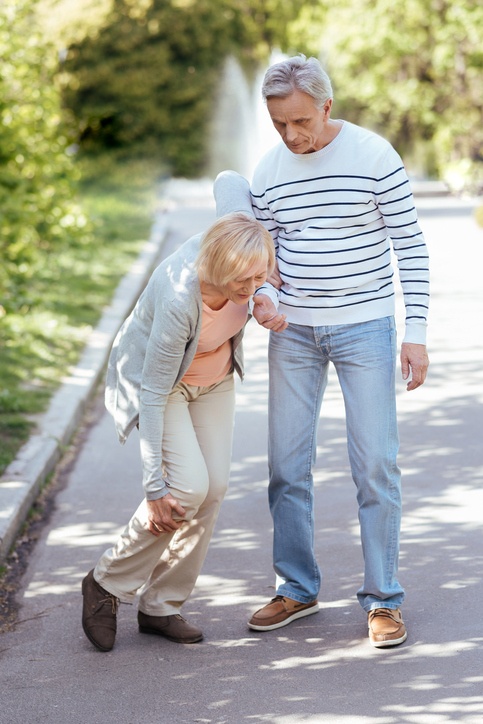Knee buckling causes, exercises and treatment options.
If you've ever felt your knee give out, then you know it can be a startling and even scary experience. Whether you were walking and took a tumble, or you started to stand up and found yourself suddenly sitting again, knee buckling is no fun. But even more importantly, it's a safety issue, and treating it can reduce the risk of falls. What causes knee buckling, and how can it be treated?
Causes of knee buckling
Typically, knee buckling is associated with a few other symptoms. The most important one, naturally, is the loss of strength in the knee when weight is put on it. There is also usually inflammation, pain, and popping sounds in the joint. All of this makes standing and walking difficult. Here are a few causes of knee buckling.
Arthritis
Both osteoarthritis and rheumatoid arthritis can cause joint damage that leads to knee instability. These also cause pain and stiffness.
Ligament injury
If one of the ligaments in the knee has been injured or torn, it can't support the knee. This injury could be caused by a fall or hyperextending or twisting the joint. Sometimes when a knee has been injured, the body will protect itself from pain by with an involuntary movement, which feels like instability.
Worn cartilage
Osteoarthritis, a lack of movement, and wear and tear can all lead to cartilage damage. Small pieces of cartilage can become calcified and get lodged between the bones of the knee. These cartilage pieces are known as loose bodies, and they can cause sudden pain and joint instability. They can also cause the knee to lock.
Dislocated kneecap
If you have a partial or complete dislocation of the kneecap, the kneecap has shifted out of place. This can be because of injury, weakness in the ligaments that hold it in place, muscle weakness in the leg, or a shallow groove in the end of the thigh bone where the kneecap is supposed to rest.
Nerve damage
One of the two major nerves in your leg is the femoral nerve. Damage to this nerve causes weakness in the muscles that support the knee, which causes instability. This damage can be caused by many things, including diabetes, injuries, heavy alcohol consumption, and neurological disorders.
Multiple Sclerosis (MS)
This autoimmune condition causes the immune system to attack the protective covering on neurons. The weakness that comes with this causes knees to buckle.
Treatment Options
If you're experiencing knee instability, the first step is to see a doctor to pinpoint the cause. Then you can explore the best treatment approach.
Non steroidal anti-inflammatory drugs (NSAIDS)
Over the counter medications such as ibuprofen, aspirin, and naproxen reduce the pain and swelling that accompanies knee instability.
R.I.C.E.
Rest, Ice, Compression, and Elevation is the gold standard response to injury. Getting off your feet, icing the knee, wrapping it up in a soft dressing, and propping it up will help heal the damage, or at least prevent it from getting worse.
Support
Providing support to the joint with braces and bandages helps take the pressure off the knee and stabilize the leg.
Prescription medication
If over the counter medications aren't enough to reduce pain and swelling, your doctor can prescribe more powerful prescription medications.
Ultrasound
Therapists use ultrasound therapy to reduce swelling and improve knee function.
Surgery
Severe damage to ligaments, tendons, and cartilage may require surgical repair.
Exercise and physical therapy
A physical therapist will design an exercise program to treat the problems in the knee. This includes exercises to strengthen weak muscles and stretches to improve flexibility. Working with a physical therapist not only helps repair damage but also prevent further problems. How long it will take depends on the problems and the extent of the damage. Because they are experts in knee rehabilitation and the many contributors to knee locking, a physical therapist is an important part of a treatment plan.
Of course, any physical therapy program works best if you work hard at home too. Here are a few of the exercises that are used to stretch and strengthen knees. Be sure to warm up gently before any exercise and take it slowly. Don't push through pain, to prevent further injury.
- Straight leg raises both lying down on your back and on your stomach
- Side leg raises
- Standing hamstring curl
- Calf raises
- Wall squats
- Low-impact cardio, such as swimming or walking
- Stretching programs, such as Tai Chi or Yoga
Knee injuries are common, and they can lead to joint instabilities. Without treatment, these conditions can get worse. Taking care of the issue early on can help prevent complications and keep you safer from the risk of falls. See your doctor to find the best course of action to help your knees be healthy and strong. For physical therapy or more information, contact us.

